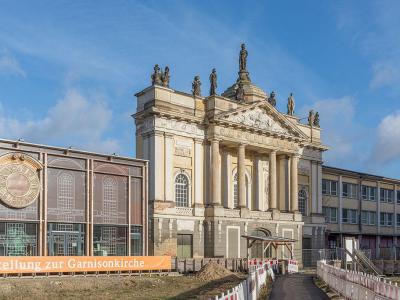Garnisonkirche (Garrison Church), Potsdam
The Garrison Church (Garnisonkirche) in Potsdam is a historically significant Protestant church that played a vital role in the early modern history of Germany. Constructed between 1730 and 1735 under the orders of King Frederick William I of Prussia, the church was designed by architect Philipp Gerlach and is celebrated as a major work of Prussian Baroque architecture. Standing at nearly 90 meters tall, it was the tallest building in Potsdam, dominating the city's skyline and forming part of the famous "Three Churches View" alongside Saint Nicholas Church and the Holy Spirit Church.
The Garrison Church held a prominent place in both religious and political life. It was a gathering site for many significant historical figures, including Johann Sebastian Bach, Alexander I of Russia, and Napoleon. The church served as the burial site for Frederick William I and his son, Frederick the Great. Moreover, it was in the Garrison Church that Potsdam's first freely elected council members met, and where Lutheran and Reformed Protestants founded the Prussian Union of Churches. The church was also a venue for classical concerts, further cementing its role as a cultural and spiritual center.
The church's interior was marked by its clear and simple design. Massive columns supported a flat roof and a two-storeyed gallery, where soldiers sat above the civilian congregation. The interior initially featured minimal ornamentation, with simple wood paneling and a wooden pulpit on the south side of the nave. In 1735, a colorful Baroque-style high altar, designed by Christian Friedrich Feldmann, was added. This altar included marble figures of Mars and Bellona by sculptor Johann Georg Glume, flanking the entrance to the crypt below.
The Garrison Church's history is marked by conflict and political turmoil, including damage from British bombing in World War II and its demolition by East Germany in 1968. Despite this, its significance endures. After German reunification, efforts to rebuild the church led to the opening of a new section in 2024, featuring a Coventry chapel, a historical exhibition, and a 57-meter viewing platform. This reconstruction symbolizes Potsdam's return to its historical roots and a commitment to peace and reflection.
The Garrison Church held a prominent place in both religious and political life. It was a gathering site for many significant historical figures, including Johann Sebastian Bach, Alexander I of Russia, and Napoleon. The church served as the burial site for Frederick William I and his son, Frederick the Great. Moreover, it was in the Garrison Church that Potsdam's first freely elected council members met, and where Lutheran and Reformed Protestants founded the Prussian Union of Churches. The church was also a venue for classical concerts, further cementing its role as a cultural and spiritual center.
The church's interior was marked by its clear and simple design. Massive columns supported a flat roof and a two-storeyed gallery, where soldiers sat above the civilian congregation. The interior initially featured minimal ornamentation, with simple wood paneling and a wooden pulpit on the south side of the nave. In 1735, a colorful Baroque-style high altar, designed by Christian Friedrich Feldmann, was added. This altar included marble figures of Mars and Bellona by sculptor Johann Georg Glume, flanking the entrance to the crypt below.
The Garrison Church's history is marked by conflict and political turmoil, including damage from British bombing in World War II and its demolition by East Germany in 1968. Despite this, its significance endures. After German reunification, efforts to rebuild the church led to the opening of a new section in 2024, featuring a Coventry chapel, a historical exhibition, and a 57-meter viewing platform. This reconstruction symbolizes Potsdam's return to its historical roots and a commitment to peace and reflection.
Want to visit this sight? Check out these Self-Guided Walking Tours in Potsdam. Alternatively, you can download the mobile app "GPSmyCity: Walks in 1K+ Cities" from Apple App Store or Google Play Store. The app turns your mobile device to a personal tour guide and it works offline, so no data plan is needed when traveling abroad.
Garnisonkirche (Garrison Church) on Map
Sight Name: Garnisonkirche (Garrison Church)
Sight Location: Potsdam, Germany (See walking tours in Potsdam)
Sight Type: Religious
Sight Location: Potsdam, Germany (See walking tours in Potsdam)
Sight Type: Religious
Walking Tours in Potsdam, Germany
Create Your Own Walk in Potsdam
Creating your own self-guided walk in Potsdam is easy and fun. Choose the city attractions that you want to see and a walk route map will be created just for you. You can even set your hotel as the start point of the walk.
Sanssouci Park Walking Tour
Sanssouci Park is a unique Potsdam landmark that occupies 290 hectares in the heart of the city. The Park is named after the Sanssouci Palace that it surrounds, which in turn takes its name from the French phrase "sans souci", which means carefree, and implies that the palace was designated as a place of fun, rather than a seat of power.
Indeed, the Sanssouci Palace was built in 1747... view more
Tour Duration: 2 Hour(s)
Travel Distance: 3.9 Km or 2.4 Miles
Indeed, the Sanssouci Palace was built in 1747... view more
Tour Duration: 2 Hour(s)
Travel Distance: 3.9 Km or 2.4 Miles
Potsdam Introduction Walking Tour
Potsdam was likely founded during the seventh century by the Hevelli tribe. The town was mentioned by the name of Poztupimi in a document from Emperor Otto III. The name likely came from an old Western Slavonic term roughly meaning "beneath the oaks."
By the early 1300s, a small town had formed with a town charter. By 1573 the town had around 2,000 people living there. Potsdam rose to... view more
Tour Duration: 2 Hour(s)
Travel Distance: 3.8 Km or 2.4 Miles
By the early 1300s, a small town had formed with a town charter. By 1573 the town had around 2,000 people living there. Potsdam rose to... view more
Tour Duration: 2 Hour(s)
Travel Distance: 3.8 Km or 2.4 Miles
Neuer Garten Walking Tour
Laid out at the behest of Friedrich William II in 1787, Potsdam's Neuer Garten (New Garden) was indeed "new" compared to the already in place Sanssouci Park.
Between 1816 and 1828, the area was modified further as an English-style, open landscape garden, with an aim to reproduce nature – trees and plants were left to grow naturally, unshaped and untrimmed. Rural life was also... view more
Tour Duration: 2 Hour(s)
Travel Distance: 2.8 Km or 1.7 Miles
Between 1816 and 1828, the area was modified further as an English-style, open landscape garden, with an aim to reproduce nature – trees and plants were left to grow naturally, unshaped and untrimmed. Rural life was also... view more
Tour Duration: 2 Hour(s)
Travel Distance: 2.8 Km or 1.7 Miles






